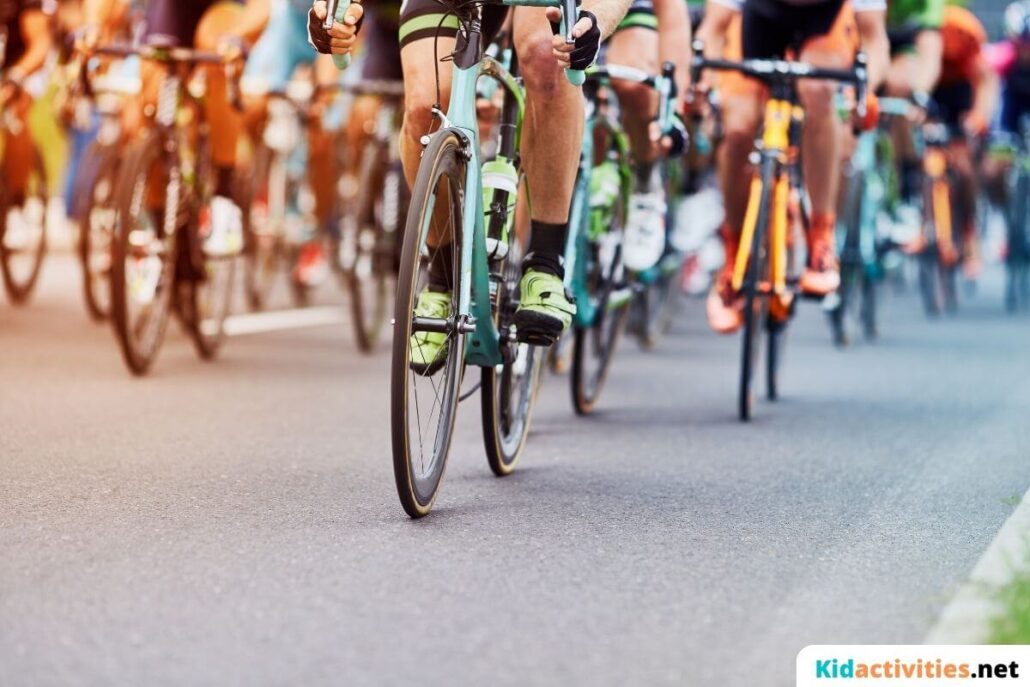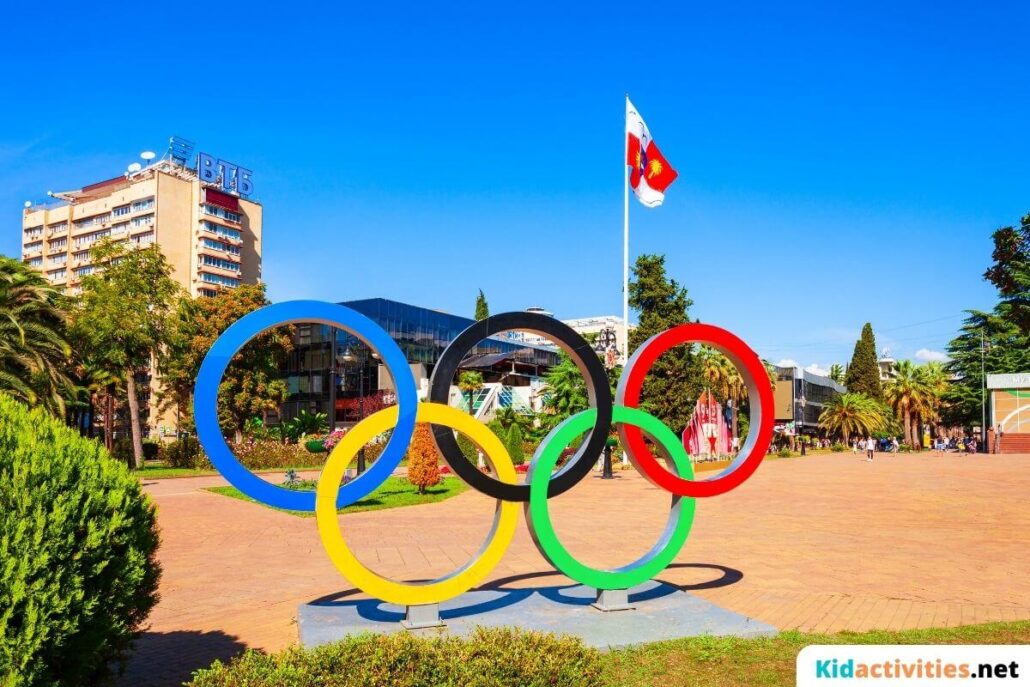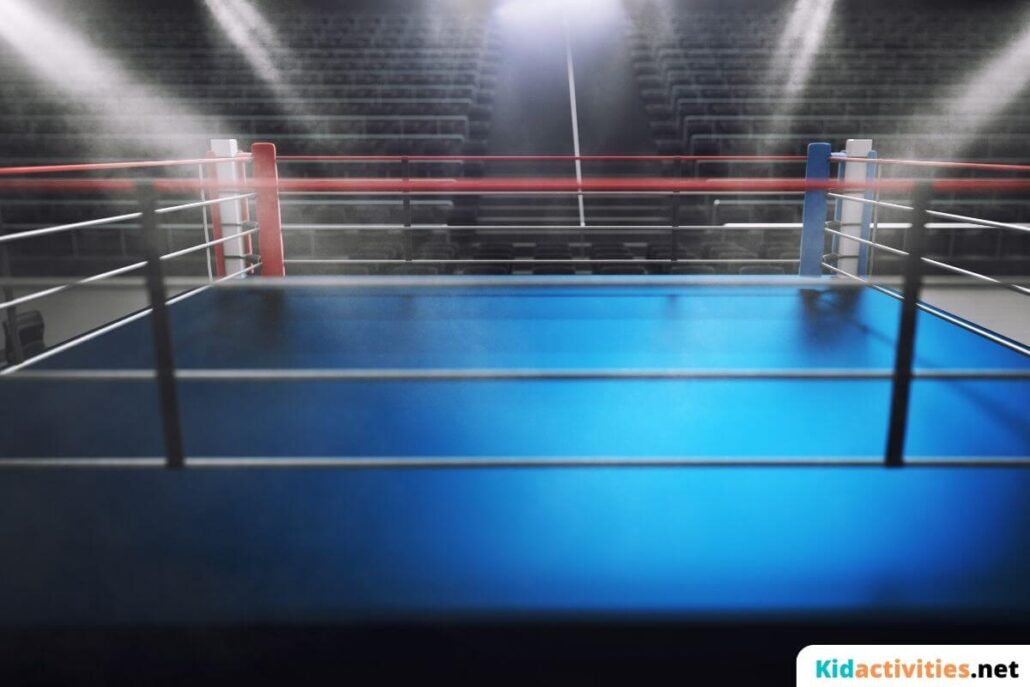The Olympics are a celebration of friendship, unity, and peace. You can host an Olympic theme day by using some of the ideas below.
We share a list of some of the summer Olympic sports and how they are played as well as some activities and Olympic themed snacks.
Olympic Themed Day Activities for Kids
1. Plan the Olympic Games for the children
- Decide how many teams you will have.
- Divide the kids into the teams.
- Have each group decorate a banner with their team name and symbol.
- Meet with staff members regarding who is to do what.
2. Olympic Day Celebration
- Explain what games will be involved in the competitions, how competitors are expected to win and lose graciously, and point out how much fun the day will be.
- Organize the children to march around an area holding their banners. Play the Olympic theme or the “Star-Spangled Banner.”
During play, Post the rules of the games and review the rules with the children and place signs where events are located. End with refreshments. Most of all, have fun. Hold a closing ceremony: everyone’s a winner! Call each child’s name, and pass out medals, certificates, and prizes
3. Cycling competition

Have the kids race on the school track with their school cycle or if they are older students, have them bring their own bicycle and have a race.
Just make sure to follow safety protocols with everyone wearing a helmet and protective gear.
4. Football match
Every kid loves football ( or soccer outside the US ). We are not talking about American Football right now, but about Soccer.
The rules are pretty known to everyone, divide the kids into small teams, and have each team play each other for a short few minutes game until the two winners are matched up in a championship game.
5. Track
Kids love to run ( most of the time ) so having a track Olympics activity will be perfect for everyone! Just get them the right shoes, and head over to the school track, and have a tournament where kids compete to see who is the fastest kid in school, and should get a gold medal
Where did the Olympic flags come from?
The five-colored rings on a white field form the Olympic Flag.
The flag was adopted in 1914, but the first Games at which it was flown were Antwerp, 1920. It is hoisted at each celebration of the Games.
What is the meaning of the Olympic rings?

The Olympic symbol consists of five interlaced rings of equal dimensions, used alone, in one or in five different colors, which are, from left to right, blue, yellow, black, green, and red.
The Olympic symbol (the Olympic rings) expresses the activity of the Olympic Movement and represents the union of the five continents and the meeting of athletes from throughout the world at the Olympic Games.
Olympic themed crafts and Olympic themed games will be a great addition to your themed day.
What events are played at the summer Olympics?
Impress the kids with how much you know. Activities follow this list
- Archery
There are both individual and team events in which archers battle in a seeded knockout tournament, firing arrows at a target from 70 meters. - Aquatics
Aquatics consists of a range of sports including swimming, diving, synchronized swimming and water polo. Open water swimming is included for the first time this year. Take a look at our fun swimming pool games. - Athletics
There are 47 different athletics events at the Olympics, 24 for men and 23 for women. There is no 50km road walk for women, who also compete in the heptathlon rather than the decathlon, but otherwise, the men’s and women’s events mirror each other. - Badminton
There are five Olympic tournaments in the world’s fastest racquet sport: men’s singles and doubles, women’s singles and doubles, as well as mixed doubles. All are straight elimination events. - Baseball
Two teams take turns batting and fielding and the object is to score the most runs in nine innings. Baseball will disappear from the Olympics in 2012. - Basketball
Each game consists of four periods of 10 minutes with five minutes of overtime allowed if a match is tied. Olympic basketball gold medals have ended up in American hands more often than not. - Boxing

There are 11 weight categories contested in Olympic boxing – from light-flyweight (under 48kg) to super heavyweight (over 91kg). Only amateur boxers between the ages of 17 and 34 are allowed to enter.
- Canoe/Kayak
Men race in both canoes and kayaks, while women compete only in the kayaks.
Flatwater canoe and kayak racing were first seen at the Olympics with a demonstration competition in 1924 before it gained full medal status in 1936. - Cycling
Men and women compete in all forms of cycling at the Olympics, although a handful of track events are only open to men. Road races take place in two forms – straight races and time trials. - Equestrian
The three equestrian disciplines – show jumping, dressage, and three-day eventing, which have been part of the Olympic Games since 1912, are the only Games that allow men and women to compete on the same terms. - Fencing
Fencing is split into three disciplines defined by the type of weapon used. Epee events use a heavier blade, foil events use a lighter blade in which only the torso is a target, while the saber is a light blade used to cut and thrust. - Football
The Olympic football competition is effectively an under-23 World Cup with 16 teams competing in the men’s tournament and 12 in the women’s. Professionals are allowed to participate, but in the men’s tournament, each nation is restricted to only three players over 23 years of age. - Gymnastics
Olympic gymnastics consists of three disciplines; artistic, rhythmic, and trampoline. Both men and women compete in gymnastics, although each discipline differs greatly with individual and team medals also competed for. - Handball
Two teams of seven compete on indoor courts to score more goals than the other by throwing the ball into the opposing net. Halves last 30 minutes, with a 10-minute break in between. - Hockey
Field hockey is a 70-minute game split into two 35-minute halves, while extra time and a penalty stroke competition may be played in the event of a tie. Both sides field 10 outfield players and a goalkeeper. - Judo
Judo is a traditional Japanese wrestling sport that dates back to the 1880s and means “the gentle way”. Men and women compete in all seven weight classes, with men contesting bouts of five minutes and women four. - Modern pentathlon
Modern pentathlon contains five sports – shooting, fencing, swimming, equestrian and running – which competitors undertake in the course of a day. It is the only event that was created specifically for the modern Olympic Games. - Rowing
There are 14 medal events in the Olympics with women competing in six of these.The competition is made up of heats with the winner progressing to a semi-final or sometimes straight to a six-boat final. - Sailing
All 11 classes are sailed in a fleet racing format, whereby contestants will race in a group around a course of buoys. Each boat earns a score equal to its finishing position, with the eventual winner having the lowest score. - Shooting
The Olympics have 15 shooting events, six for women and nine for men. For the rifle and pistol categories, competitors shoot at targets on the shooting range. The shotgun category sees competitors shoot at clay targets. - Softball
Softball is the sole women-only sport in the Olympics. The game is similar to baseball, with some key differences. Women’s fast-pitch, the variation used is played over seven innings rather than nine, with a larger ball and pitching is underarm. - Table Tennis
Table tennis lays claim to the title of the world’s largest participation sport – a fact attributed to its immense popularity in the Far East. There are four Olympic table tennis tournaments – singles and doubles for both men and women. - Tae kwon do
Tae kwon do is one of many Korean martial art forms dating back to the early 20th century. Men and women each compete in four different weight classes ranging From 80kg and above in men to below 49kg in women. - Tennis
All Olympic tennis competitions are decided on a knockout basis. Each nation may enter a maximum of six singles players and four doubles teams, who are put in different sections of the draw. For the singles competition, 16 players are seeded, while the doubles draw includes eight seeded teams. We have a list of 11 tennis games and drills. - Triathlon
The Olympic triathlon, a continuous distance race consisting of swimming, cycling and running, is contested by men and women in individual races. The event is made up of a 1.5km swim followed by a 40km cycle and ending in a 10km run. - Volleyball
Indoor volleyball is played by teams of six over a maximum of five sets, with the first four won by the team who reaches 25 and the fifth by the team who reaches 15, though they must have a two-point advantage. The beach variety takes place on a smaller court with teams of two players. - Weightlifting
There are two techniques in Olympic weightlifting – the snatch and the clean and jerk – both performed by each athlete. There are eight weight categories in the men’s event, ranging from 56kg to over 105kg. In the women’s there are seven, starting at 48kg and going through to the over 75kg category. - Wrestling
Men’s wrestling is contested in seven weight categories from bantamweight to super heavyweight. All seven are contested in both Greco-Roman and freestyle. For women, there is no Greco-Roman.
Olympic Games Snack Ideas
Olympic Rings Cookie Snack
Ingredients:
- Five Home-made or purchased “ring” cookies (round cookies with a hole in the center) per child.
- “Writing frosting” in red, green, black, blue, and yellow or add food coloring to white frosting.
Instructions
- Decorate each cookie with a different color frosting.
- Layout the cookies on a plate in the pattern of the Olympic rings.
- Enjoy and Eat!
Friendship Snacks
Instructions
- Have each child bring in a half cup of their favorite snack (You can offer parents suggestion at this point: cereal, raisins, crackers, etc)
- When you get all of the snacks, mix them all in a huge bowl, and serve them for a snack.
- Talk about how different things go together to make something very good. This helps get the ideas of diversity, sharing, cooperation, and trying new things across.
Friendship Fruit Bowl
Instructions
- Do the same as above, however, use fruit instead of snack mixes.
- Have each child bring in one can or piece of fresh fruit
- Talk about how different things go together, to make something very good. This helps get the ideas of diversity, sharing, cooperation, and trying new things across.
- Donate any left-over cans to a shelter
Check out the Patriotic-Red, White & Blue Category as well as our post on how to play carpet ball.
Olympic Games Caution Tips
Use caution when it’s hot outside, especially for active kids. In high temperatures, kids don’t sweat as much as adults do, so it’s harder for them to cool off. This makes them more at risk for dehydration and heat exhaustion.
When it’s hot outside and kids are playing sports-or even just actively playing-head off problems by making sure they drink fluids before, during, and after activity. As a guideline, encourage at least 4 ounces of fluid every 15-20 minutes, or whenever there’s a break or time-out.
Tip: One ounce equals about one “gulp” therefore 4 gulps are needed for every 15 to 20 minutes!



